Influence of Wood Properties and Building Construction on Energy Demand, Thermal Comfort and Start-Up Lag Time of Radiant Floor Heating Systems
Abstract
:1. Introduction
2. Simulation Models
2.1. Detailed Radiant Floor Thermal Modelling
2.2. Coupling the Building and Radiant Floor Thermal Models
2.3. Experimental Validation of the Radiant Floor Model
3. Simulation Description
3.1. Radiant Floor Layout and Material Properties
3.2. Building Characteristics
- Glazed area: 15%, 30%, or 80%;
- Envelope insulation (U-value): window, outer wall, and roof insulation were rated for the simulations as low, medium, or high depending on the respective U-values (Appendix B, Table A2), with high meaning better U-values than required by current legislation; medium meaning compliance-level; and low meaning non-conformity, i.e., as a rule, buildings 20 years old or over;
- Heat capacity: the three levels of heat capacity applied, low, medium, and high, were defined as per standard ISO 52016-1:2017 [82]);
- Orientation: the orientations adopted for interior dwellings were south, east, and west, and for corner dwellings, southeast, southwest, northeast, and northwest.
3.3. Simulation Types
4. Simulation Results and Discussion
4.1. General Trends in Performance
4.2. Effect of Building Construction
4.3. Effect of Wood Thermal Conductivity
4.4. Effect of Wood Thermal Resistance
5. Conclusions
- For most dwellings, the thermal properties of the wood affected energy demand and thermal comfort only scantly. Wood coverings delivered mostly similar and, in some cases, better results than granite coverings in those two respects. The impact of wood properties on demand and comfort was only significant for corner-located, poorly insulated dwellings. In such cases, granite flooring exhibited consistently higher thermal performance, although when appropriate wood properties were chosen, they proved to be a very close competitor to granite. These findings were not always associated with high thermal conductivity only. The average energy demand was observed to be lower in the wood than in the granite coverings in 25% of the dwellings simulated. Similarly, on average, wood lagged behind granite in thermal comfort by less than 1 h in 50% of the dwellings.
- Wood properties played a more substantial role in start-up lag times than in demand or thermal comfort, although the general pattern was much the same: for most dwellings, none of the wood radiant floors simulated lengthened the lag time substantially. As a rule, the dwellings where energy loss was greatest (corner dwellings, those with medium or high percentages of glazing, those that were minimally or only moderately insulated and oriented toward the north, east, or west) required a suitable choice of wood properties to prevent lag times from rising inordinately. The average difference in start-up lag time between the wood and granite coverings was less than 3 h for 75% of the dwellings. It is not possible to set a general time limit beyond which the start-up lag time is unacceptable, as this depends on the use of the dwelling, e.g., whether it is for tourism or for continuous use.
- Despite the scant impact of wood properties in most cases, the pursuit of simple rules to determine which properties would be the most suitable under given circumstances proved to be futile because the combination of wood properties, thickness, and dwelling construction characteristics followed no consistent pattern. The conclusion drawn, therefore, was that cover properties should be studied case-by-case to determine those expected to deliver the best thermal performance.
- In most cases, the highest thermal conductivity values were found to minimise energy demand, maximise comfort, and shorten start-up lag times. Energy demand was minimised primarily when thermal conductivity was higher than 0.20 W/(m·K), although in a significant 18% of cases, demand was minimised at conductivities of under 0.1 W/(m·K). When wood conductivity was highest (0.20 W/(m·K) to 0.26 W/(m·K)), comfort was maximised in a greater percentage of cases than when it was lowest, although in this case, the highest comfort levels were found in 14% of cases with conductivities under 0.10 W/(m·K) and 16% of cases with values of 0.10 to 0.12 W/(m·K). Conductivities of 0.18 W/(m·K) often increased the start-up lag time by only 15 min in well-insulated, low-energy-demand dwellings and in nearly all such dwellings, the conductivity value increases it by 30 min. On these grounds, wood with high thermal conductivity cannot be said to always be necessary for the design of radiant floors.
- One of the conclusions of this study that may be of most immediate interest is that the lowest thermal conductivity and thickest floor covering, i.e., wood flooring with the highest thermal resistance (even more of 0.15 m2K/W value) does not significantly affect the energy demand or thermal comfort. On average, wood flooring lowered energy demand by 6.4% and daily hours of thermal comfort by a mere 1.6% relative to granite coverings.
- The findings on the thermal resistance of wood coverings provided no justification for establishing an upper limit that must not be exceeded in the selection of woods for radiant floors. Although European standard EN 1264-2 [85] makes no provision for coverings with thermal resistance values of over 0.15 m2K/W, they are not explicitly prohibited. In fact, thermal resistance values higher than 0.15 m2K/W did not raise energy demand significantly, nor did they lower the number of comfort hours in the vast majority of the conditions simulated. This study consequently suggests that the standard should be revised and the reference to that value deleted, since manufacturers have misconstrued it to be a limit not to be exceeded in the design of wood-covered radiant flooring.
- It was shown that the thermal behavior of radiant floor heating systems is closely linked to building conditions and, therefore, it is necessary to carry out a technical study for each particular case.
Author Contributions
Funding
Institutional Review Board Statement
Informed Consent Statement
Acknowledgments
Conflicts of Interest
Nomenclature
| Area | m2 | |
| Air changes per hour | h−1 | |
| Thermal capacitance | J/K | |
| Specific heat | J/(kgK) | |
| Response factors of the radiant floor | ||
| F | View factor | |
| Solar incident global irradiation | W/m2 | |
| Convective heat transfer coefficient | W/(m2K) | |
| Heat flux density | W/m2 | |
| Heat transfer rate | W | |
| Thermal resistance | (m2K)/W | |
| Solar heat gain coefficient of windows, including frames | ||
| Time | s | |
| Temperature | °C | |
| Overall heat transfer coefficient | W/(m2K) | |
| Volumetric air flow rate | m3/s | |
| Greek symbols | ||
| Density | kg/m3 | |
| Subscripts | ||
| air | Air | |
| build | Building | |
| c | Convective | |
| cr | Convective and radiant | |
| eq | Equivalent | |
| e | Exterior enclosures | |
| floor | Floor | |
| i | Indoor, Interior partitions | |
| r | radiant | |
| s | Surface | |
| sa | Sol-air | |
| w | Window | |
| walls | walls | |
| 1 | Top surface of radiant floor | |
| 2 | Bottom surface of radiant floor | |
| 3 | Pipe surface of radiant floor | |
Appendix A. Development of the Simulation Models
Appendix A.1. Detailed Radiant Floor Thermal Model
Appendix A.2. Building the Thermal Model
Appendix B. Values of Building Parameters Chosen for Simulations
Appendix B.1. Heat Capacity (C)
| Class | Effective Heat Capacity [kJ/(m2K)] |
|---|---|
| Very light | 80 |
| Medium | 165 |
| Very heavy | 370 |
Appendix B.2. Overall Heat Transfer Coefficient (U-Value)
| U-Value [W/(m2K)] | ||||
|---|---|---|---|---|
| Insulation Level | Wall | Roof | Windows | Windows SHGC |
| Low | 0.79 | 0.47 | 5.70 | 0.72 |
| Medium | 0.53 | 0.31 | 2.80 | 0.63 |
| High | 0.30 | 0.16 | 1.60 | 0.49 |
Appendix B.3. Overall Heat Transfer Coefficient between Indoor Spaces
Appendix B.4. Area of Interior and Exterior Enclosures
| Corner Dwelling | Interior Dwelling | |
|---|---|---|
| Floor | 90.25 | 90.25 |
| Interior vertical partitions to adyacent spaces | 57 | 85.5 |
| Interior horizontal partitions to upper adyacent spaces | 0 | 90.25 |
| Façade wall | 57 | 28.5 |
| Window area * | 8.55/17.1/34.2 | 4.275/8.55/17.1 |
| Roof | 90.25 | 0 |
Appendix B.5. Radiant Floor Surface Convection-Radiation Heat Transfer Coefficients
Appendix B.6. Building Model Boundary Conditions
Appendix B.6.1. Sol-Air Temperature
Appendix B.6.2. Adjacent Indoor Space Temperatures
Appendix B.6.3. Internal Gain and Ventilation Values
| Time of Day | 1 | 2 | 3 | 4 | 5 | 6 | 7 | 8 | 9 | 10 | 11 | 12 | 13 | 14 | 15 | 16 | 17 | 18 | 19 | 20 | 21 | 22 | 23 | 24 |
|---|---|---|---|---|---|---|---|---|---|---|---|---|---|---|---|---|---|---|---|---|---|---|---|---|
| Occupancy | 2.15 | 2.15 | 2.15 | 2.15 | 2.15 | 2.15 | 2.15 | 0.54 | 0.54 | 0.54 | 0.54 | 0.54 | 0.54 | 0.54 | 0.54 | 1.08 | 1.08 | 1.08 | 1.08 | 1.08 | 1.08 | 1.08 | 1.08 | 2.15 |
| Illumination | 0.44 | 0.44 | 0.44 | 0.44 | 0.44 | 0.44 | 0.44 | 1.32 | 1.32 | 1.32 | 1.32 | 1.32 | 1.32 | 1.32 | 1.32 | 1.32 | 1.32 | 1.32 | 2.2 | 4.4 | 4.4 | 4.4 | 4.4 | 2.2 |
| Appliances | 0.44 | 0.44 | 0.44 | 0.44 | 0.44 | 0.44 | 0.44 | 1.32 | 1.32 | 1.32 | 1.32 | 1.32 | 1.32 | 1.32 | 1.32 | 1.32 | 1.32 | 1.32 | 2.2 | 4.4 | 4.4 | 4.4 | 4.4 | 2.2 |
| Total | 3.03 | 3.03 | 3.03 | 3.03 | 3.03 | 3.03 | 3.03 | 3.18 | 3.18 | 3.18 | 3.18 | 3.18 | 3.18 | 3.18 | 3.18 | 3.72 | 3.72 | 3.72 | 5.48 | 9.88 | 9.88 | 9.88 | 9.88 | 6.55 |
Appendix B.7. Radiant Floor Operation. Timing, Set Points, and Water Temperature
Appendix C. Explanation of Start-Up Lag Time Discontinuity
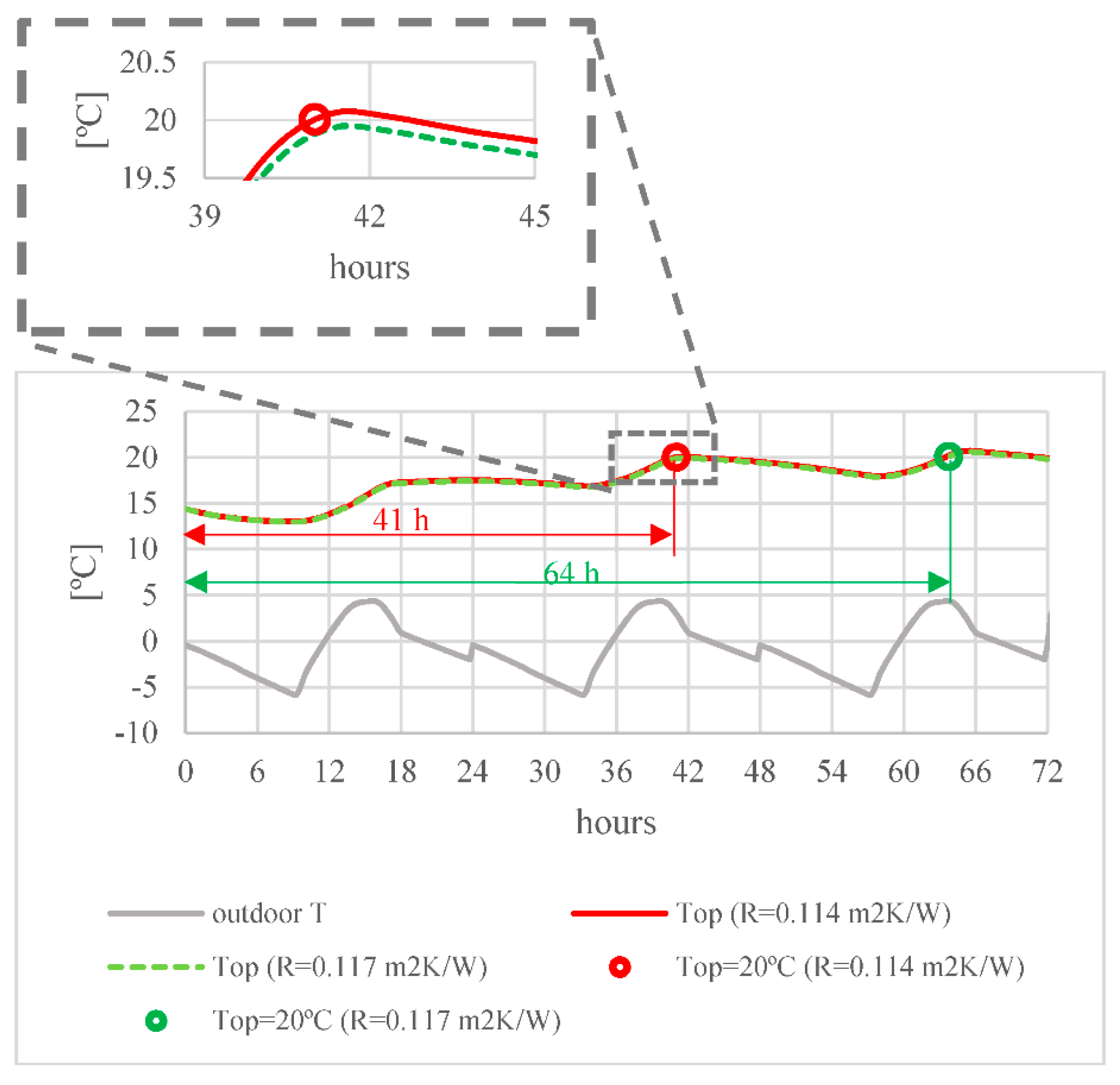
References
- Chu, W.-S.; Kim, M.-S.; Lee, K.-T.; Bhandari, B.; Lee, G.-Y.; Yoon, H.-S.; Kim, H.-S.; Park, J.-I.; Bilegt, E.; Lee, J.-Y.; et al. Design and performance evaluation of Korean traditional heating system—Ondol: Case study of Nepal. Energy Build. 2017, 138, 406–414. [Google Scholar] [CrossRef]
- Zhuang, Z.; Li, Y.; Chen, B.; Guo, J. Chinese kang as a domestic heating system in rural northern China—A review. Energy Build. 2009, 41, 111–119. [Google Scholar] [CrossRef]
- Rook, T. The development and operation of Roman hypocausted baths. J. Archaeol. Sci. 1978, 5, 269–282. [Google Scholar] [CrossRef]
- Bean, R.; Olesen, B.W.; Kim, K.W. History of Radiant Heating and Cooling Systems (Part 1). Ashrae J. 2010, 52, 40–45. Available online: http://search.ebscohost.com/login.aspx?direct=true&db=egs&AN=47756416&site=eds-live (accessed on 1 September 2021).
- Bean, R.; Olesen, B.W.; Kim, K.W. History of Radiant Heating and Cooling Systems (Part 2). Ashrae J. 2010, 52, 50–55. [Google Scholar]
- Sarbu, I.; Mirza, M.; Crasmareanu, E. Performance of Radiant Heating Systems of Low-Energy Buildings. IOP Conf. Ser. Mater. Sci. Eng. 2017, 245, 32088. [Google Scholar] [CrossRef]
- History of Underfloor Heating. Underfloor Heating Past to Present, (n.d.). Available online: https://www.easyflow.org.uk/history-of-underfloor-heating/ (accessed on 8 July 2021).
- Rhee, K.-N.; Olesen, B.W.; Kim, K.W. Ten questions about radiant heating and cooling systems. Build. Environ. 2017, 112, 367–381. [Google Scholar] [CrossRef] [Green Version]
- Lin, B.; Wang, Z.; Sun, H.; Zhu, Y.; Ouyang, Q. Evaluation and comparison of thermal comfort of convective and radiant heating terminals in office buildings. Build. Environ. 2016, 106, 91–102. [Google Scholar] [CrossRef]
- Izquierdo, M.; Camacho, P.D.A. Solar heating by radiant floor: Experimental results and emission reduction obtained with a micro photovoltaic–heat pump system. Appl. Energy 2015, 147, 297–307. [Google Scholar] [CrossRef]
- Yang, F.; Liu, J.; Sun, Q.; Cheng, L.; Wennersten, R. Simulation analysis of household solar assistant radiant floor heating system in cold area. Energy Procedia 2019, 158, 631–636. [Google Scholar] [CrossRef]
- Sebarchievici, C.; Dan, D.; Sarbu, I. Performance Assessment of a Ground-coupled Heat Pump for an Office Room Heating using Radiator or Radiant Floor Heating Systems. Procedia Eng. 2015, 118, 88–100. [Google Scholar] [CrossRef] [Green Version]
- Zhang, L.; Huang, X.; Liang, L.; Liu, J. Experimental study on heating characteristics and control strategies of ground source heat pump and radiant floor heating system in an office building. Procedia Eng. 2017, 205, 4060–4066. [Google Scholar] [CrossRef]
- Pajchrowski, G.; Noskowiak, A. Thermal conductivity of wooden floors in the context of underfloor heating system applications. Drewno 2018, 61, 145–152. [Google Scholar]
- Rhee, K.-N.; Kim, K.W. A 50 year review of basic and applied research in radiant heating and cooling systems for the built environment. Build. Environ. 2015, 91, 166–190. [Google Scholar] [CrossRef]
- Zhang, D.; Cai, N.; Cui, X.; Xia, X.; Shi, J.; Huang, X. Experimental investigation on model predictive control of radiant floor cooling combined with underfloor ventilation system. Energy 2019, 176, 23–33. [Google Scholar] [CrossRef]
- Shin, M.-S.; Rhee, K.-N.; Jung, G.-J. Optimal heating start and stop control based on the inferred occupancy schedule in a household with radiant floor heating system. Energy Build. 2020, 209, 109737. [Google Scholar] [CrossRef]
- Chen, Q.; Li, N.; Feng, W. Model predictive control optimization for rapid response and energy efficiency based on the state-space model of a radiant floor heating system. Energy Build. 2021, 238, 110832. [Google Scholar] [CrossRef]
- Tahersima, M.; Tikalsky, P. Experimental and numerical study on heating performance of the mass and thin concrete radiant floors with ground source systems. Constr. Build. Mater. 2018, 178, 360–371. [Google Scholar] [CrossRef]
- Krajčík, M.; Šikula, O. Heat storage efficiency and effective thermal output: Indicators of thermal response and output of radiant heating and cooling systems. Energy Build. 2020, 229, 110524. [Google Scholar] [CrossRef]
- Jeon, J.; Jeong, S.-G.; Lee, J.-H.; Seo, J.; Kim, S. High thermal performance composite PCMs loading xGnP for application to building using radiant floor heating system. Sol. Energy Mater. Sol. Cells 2012, 101, 51–56. [Google Scholar] [CrossRef]
- Zhang, D.; Cai, N.; Wang, Z. Experimental and numerical analysis of lightweight radiant floor heating system. Energy Build. 2013, 61, 260–266. [Google Scholar] [CrossRef]
- Zhou, G.; He, J. Thermal performance of a radiant floor heating system with different heat storage materials and heating pipes. Appl. Energy 2015, 138, 648–660. [Google Scholar] [CrossRef]
- Fu, W.; Lu, Y.; Zhang, R.; Liu, J.; Zhang, T. Developing NaAc∙3H2O-based composite phase change material using glycine as temperature regulator and expanded graphite as supporting material for use in floor radiant heating. J. Mol. Liq. 2020, 317, 113932. [Google Scholar] [CrossRef]
- Mohammadzadeh, A.; Kavgic, M. Multivariable optimization of PCM-enhanced radiant floor of a highly glazed study room in cold climates. Build. Simul. 2019, 13, 559–574. [Google Scholar] [CrossRef]
- González, B.; Prieto, M. Radiant heating floors with PCM bands for thermal energy storage: A numerical analysis. Int. J. Therm. Sci. 2021, 162, 106803. [Google Scholar] [CrossRef]
- Larwa, B.; Cesari, S.; Bottarelli, M. Study on thermal performance of a PCM enhanced hydronic radiant floor heating system. Energy 2021, 225, 120245. [Google Scholar] [CrossRef]
- Cho, J.; Park, B.; Lim, T. Experimental and numerical study on the application of low-temperature radiant floor heating system with capillary tube: Thermal performance analysis. Appl. Therm. Eng. 2019, 163, 114360. [Google Scholar] [CrossRef]
- Sattari, S.; Farhanieh, B. A parametric study on radiant floor heating system performance. Renew. Energy 2006, 31, 1617–1626. [Google Scholar] [CrossRef]
- Rambaldi, E.; Prete, F.; Timellini, G. Thermal and Acoustic Performances of Porcelain Stoneware Tiles, n.d. Available online: www.qualicer.org (accessed on 13 March 2020).
- Zhao, H.Q.; Wang, Z.H.; Zhang, L.S. Influence of Covering Layer on Surface Temperature of Floor Radiant Heating System. Appl. Mech. Mater. 2012, 204–208, 4260–4263. [Google Scholar] [CrossRef]
- Seo, J.; Jeon, J.; Lee, J.-H.; Kim, S. Thermal performance analysis according to wood flooring structure for energy conservation in radiant floor heating systems. Energy Build. 2011, 43, 2039–2042. [Google Scholar] [CrossRef]
- Athienitis, A.; Chen, Y. The effect of solar radiation on dynamic thermal performance of floor heating systems. Sol. Energy 2000, 69, 229–237. [Google Scholar] [CrossRef]
- UNE. Water Based Surface Embedded Heating and Cooling Systems—Part 1: Definitions and Symbols; UNE-EN 1264-1:2012; AENOR; UNE: Madrid, Spain, 2012. [Google Scholar]
- Meteonorm. 2005. Available online: http://meteonorm.com/ (accessed on 1 September 2012).
- Xu, X.; Wang, S. A simplified dynamic model for existing buildings using CTF and thermal network models. Int. J. Therm. Sci. 2008, 47, 1249–1262. [Google Scholar] [CrossRef]
- Building Environment Design—Design, Dimensioning, Installation and Control of Embedded Radiant Heating and Cooling Systems—Part 4: Dimensioning and Calculation of the Dynamic Heating and Cooling Capacity of Thermo Active Build. ISO—ISO 11855-4:2012. 2012. Available online: https://www.iso.org/standard/52410.html (accessed on 3 September 2020).
- Yu, G.; Chen, H.; Xiong, L.; Du, C. A simplified dynamic model based on response factor method for thermal performance analysis of capillary radiant floors. Sci. Technol. Built Environ. 2019, 25, 450–463. [Google Scholar] [CrossRef]
- Strand, R.K. Heat Source Transfer Functions and Their Application to Low Temperature Radiant Heating Systems; University of Illinois at Urbana Champaign, Department of Mechanical and Industrial Engineering: Champaign, IL, USA, 1995. [Google Scholar]
- Strand, R.K.; Pedersen, C.O. Implementation of a radiant heating and cooling model into an integrated building energy analysis program. Ashrae Trans. 1997, 103, 949–958. Available online: https://experts.illinois.edu/en/publications/implementation-of-a-radiant-heating-and-cooling-model-into-an-int (accessed on 9 March 2021).
- Mltalas, G.P.; Stephenson, D.G. Room Thermal Response Factors. Ashrae Trans. 1967, 73 Pt 1, 1.1–1.7. [Google Scholar]
- Mitalas, G.P. Calculation of transient heat flow through walls and roofs. Ashrae Trans. 1968, 74, 182–188. [Google Scholar]
- Underwood, C.P.; Yik, F.W.H. Modelling Methods for Energy in Buildings; Blackwell Publishing Ltd.: Oxford, UK, 2004. [Google Scholar]
- Engineering Simulation & 3D Design Software | Ansys, (n.d.). Available online: http://www.ansys.com (accessed on 3 September 2018).
- Li, Y.; Castiglione, J.; Astroza, R.; Chen, Y. Real-time thermal dynamic analysis of a house using RC models and joint state-parameter estimation. Build. Environ. 2021, 188, 107184. [Google Scholar] [CrossRef]
- Wang, Z.; Chen, Y.; Li, Y. Development of RC model for thermal dynamic analysis of buildings through model structure simplification. Energy Build. 2019, 195, 51–67. [Google Scholar] [CrossRef]
- Vivian, J.; Zarrella, A.; Emmi, G.; De Carli, M. An evaluation of the suitability of lumped-capacitance models in calculating energy needs and thermal behaviour of buildings. Energy Build. 2017, 150, 447–465. [Google Scholar] [CrossRef]
- Zarrella, A.; Prataviera, E.; Romano, P.; Carnieletto, L.; Vivian, J. Analysis and application of a lumped-capacitance model for urban building energy modelling. Sustain. Cities Soc. 2020, 63, 102450. [Google Scholar] [CrossRef]
- Wang, S.; Xu, X. Simplified building model for transient thermal performance estimation using GA-based parameter identification. Int. J. Therm. Sci. 2006, 45, 419–432. [Google Scholar] [CrossRef]
- Wang, J.; Chen, H.; Yuan, Y.; Huang, Y. A novel efficient optimization algorithm for parameter estimation of building thermal dynamic models. Build. Environ. 2019, 153, 233–240. [Google Scholar] [CrossRef]
- Bueno, B.; Norford, L.; Pigeon, G.; Britter, R. A resistance-capacitance network model for the analysis of the interactions between the energy performance of buildings and the urban climate. Build. Environ. 2012, 54, 116–125. [Google Scholar] [CrossRef]
- Shen, P.; Braham, W.; Yi, Y. Development of a lightweight building simulation tool using simplified zone thermal coupling for fast parametric study. Appl. Energy 2018, 223, 188–214. [Google Scholar] [CrossRef]
- Ogunsola, O.; Song, L. Application of a simplified thermal network model for real-time thermal load estimation. Energy Build. 2015, 96, 309–318. [Google Scholar] [CrossRef]
- Juricic, S.; Goffart, J.; Rouchier, S.; Foucquier, A.; Cellier, N.; Fraisse, G. Influence of natural weather variability on the thermal characterisation of a building envelope. Appl. Energy 2021, 288, 116582. [Google Scholar] [CrossRef]
- Brastein, O.; Perera, D.; Pfeifer, C.; Skeie, N.-O. Parameter estimation for grey-box models of building thermal behaviour. Energy Build. 2018, 169, 58–68. [Google Scholar] [CrossRef] [Green Version]
- Cui, B.; Fan, C.; Munk, J.; Mao, N.; Xiao, F.; Dong, J.; Kuruganti, T. A hybrid building thermal modeling approach for predicting temperatures in typical, detached, two-story houses. Appl. Energy 2019, 236, 101–116. [Google Scholar] [CrossRef]
- Joe, J.; Karava, P. A model predictive control strategy to optimize the performance of radiant floor heating and cooling systems in office buildings. Appl. Energy 2019, 245, 65–77. [Google Scholar] [CrossRef]
- Weber, T.; Jóhannesson, G.; Koschenz, M.; Lehmann, B.; Baumgartner, T. Validation of a FEM-program (frequency-domain) and a simplified RC-model (time-domain) for thermally activated building component systems (TABS) using measurement data. Energy Build. 2005, 37, 707–724. [Google Scholar] [CrossRef]
- O’Callaghan, P.; Probert, S. Sol-air temperature. Appl. Energy 1977, 3, 307–311. [Google Scholar] [CrossRef]
- Rodríguez, E.A.; Sánchez, F.J.; Catalán, A.; Rincón, A.; Fernández, J.M.R.; Galán, C.; Fernández-Nieto, E.D.; Narbona-Reina, G. Building and surroundings. Thermal and aeraulic coupling within the Special Session Applied Mathematics in Architecture. In Proceedings of the XXIV Congress on Differential Equations and Applications/XIV Congress on Applied Mathematics, Cádiz, Spain, 8–12 June 2015; pp. 157–162. [Google Scholar]
- CIBSE, Environmental Design: Guide A, 2006. Available online: https://www.cibse.org/knowledge/knowledge-items/detail?id=a0q20000008I79JAAS (accessed on 8 July 2021).
- UNE. Ergonomics of the Thermal Environment—Analytical Determination and Interpretation of Thermal Comfort Using Calculation of the PMV and PPD Indices and Local Thermal Comfort Criteria; EN ISO 7730; AENOR; UNE: Madrid, Spain, 2006. [Google Scholar]
- UNE. Ergonomics of the Thermal Environment—Instruments for Measuring Physical Quantities; ISO 7726:1998; AENOR; UNE: Madrid, Spain, 2002; Available online: https://www.une.org/encuentra-tu-norma/busca-tu-norma/norma?c=N0037517 (accessed on 14 July 2021).
- UNE. Radiadores y Convectores. Parte 2: Métodos de Ensayo y de Evaluación; UNE-EN 442-2:2015; AENOR; UNE: Madrid, Spain, 2015; Available online: https://www.une.org/encuentra-tu-norma/busca-tu-norma/norma?c=N0055707 (accessed on 24 August 2020).
- Gnielinski, V. Neue Gleichungen für den Wärme- und den Stoffübergang in turbulent durchströmten Rohren und Kanälen. Forsch. Ing. 1975, 41, 8–16. [Google Scholar] [CrossRef]
- UNE. Suelos de Madera. Colocación. Especificaciones; UNE 56810:2013; AENOR; UNE: Madrid, Spain, 2013; Available online: https://www.une.org/encuentra-tu-norma/busca-tu-norma/norma?c=N0051820 (accessed on 11 September 2020).
- Suleiman, B.M.; Larfeldt, J.; Leckner, B.; Gustavsson, M. Thermal conductivity and diffusivity of wood. Wood Sci. Technol. 1999, 33, 465–473. [Google Scholar] [CrossRef]
- Vololonirina, O.; Coutand, M.; Perrin, B. Characterization of hygrothermal properties of wood-based products—Impact of moisture content and temperature. Constr. Build. Mater. 2014, 63, 223–233. [Google Scholar] [CrossRef] [Green Version]
- Oliva, A.G.; Pulgar, F.P. Physical and mechanical characteristics of the woods of Spain. Minist. Agric. Inst. For. Investig. Exp. 1967. Available online: https://agris.fao.org/agris-search/search.do?recordID=US201300482508 (accessed on 23 July 2020).
- Tenwolde, A.; McNatt, J.D.; Krahn, L. Thermal Properties of Wood and Wood Panel Products for Use in Buildings; DOE/OR/21697-1; 6059532; Forest Service: Madison, WI, USA, 1988. [Google Scholar] [CrossRef]
- Leon, G.; Cruz-De-Leon, J.; Villasenor, L. Thermal characterization of pine wood by photoacoustic and photothermal techniques. Holz Roh Werkst. 2000, 58, 241–246. [Google Scholar] [CrossRef]
- Wood Density Chart|Workshop, (n.d.). Available online: https://cedarstripkayak.wordpress.com/lumber-selection/162-2/ (accessed on 28 July 2020).
- Carman, A.P.; Nelson, R.A. Thermal conductivity and diffusivity of concrete. J. Frankl. Inst. 1922, 193, 120. [Google Scholar] [CrossRef]
- Vay, O.; De Borst, K.; Hansmann, C.; Teischinger, A.; Müller, U. Thermal conductivity of wood at angles to the principal anatomical directions. Wood Sci. Technol. 2015, 49, 577–589. [Google Scholar] [CrossRef]
- Sonderegger, W.; Hering, S.; Niemz, P. Thermal behaviour of Norway spruce and European beech in and between the principal anatomical directions. Holzforschung 2011, 65, 369–375. [Google Scholar] [CrossRef]
- Kol, H.Ş.; Sefil, Y. The thermal conductivity of fir and beech wood heat treated at 170, 180, 190, 200, and 212 °C. J. Appl. Polym. Sci. 2011, 121, 2473–2480. [Google Scholar] [CrossRef]
- European Beech|The Wood Database—Lumber Identification (Hardwood), (n.d.). Available online: https://www.wood-database.com/european-beech/ (accessed on 28 July 2020).
- Las Propiedades de la Madera de Fresno Europeo, (n.d.). Available online: https://www.castor.es/fresno.html (accessed on 28 July 2020).
- Ficha Técnica de la Madera de Fresno Europeo, (n.d.). Available online: https://www.maderasmedina.com/fichas-propiedades/maderas-frondosas/fresno-europeo.html# (accessed on 28 July 2020).
- A. Instituto Eduardo Torroja de Ciencias de la Construcción, CEPCO, Catálogo de Elementos Constructivos, Código Técnico La Edif. CTE. 3 (2010) 141. Available online: http://www.codigotecnico.org/web/recursos/aplicaciones/contenido/texto_0012.html (accessed on 29 July 2020).
- Alonso, F.; María, L.; Riocerezo, G. Distribución de la Superficie de la Vivienda En España, (n.d.). Available online: https://www.mitma.gob.es/recursos_mfom/pdf/CD7DD6BD-2F2A-4737-B8C3-2113291E69A3/99250/dsv1.pdf (accessed on 15 July 2020).
- UNE. Energy Performance of Buildings—Energy Needs for Heating and Cooling, Internal Temperatures and Sensible ans Latent Heat Loads—Part 1: Calculation Procedures (ISO 52016-1:2017); UNE-EN ISO 52016-1:2017; AENOR; UNE: Madrid, Spain, 2017. [Google Scholar]
- UNE. Sistemas de Calefacción y Refrigeración de Circulación de agua Integrados en Superficies. Parte 2: Suelo Radiante: Métodos para la Determinación de la Emisión Térmica de los suelos Radiantes por Cálculo y Ensayo; UNE-EN 1264-2:2009+A1:2013; AENOR; UNE: Madrid, Spain, 2013; Available online: https://www.une.org/encuentra-tu-norma/busca-tu-norma/norma?c=N0051332 (accessed on 24 August 2020).
- Zhao, Q.; Lian, Z.; Lai, D. Thermal comfort models and their developments: A review. Energy Built Environ. 2021, 2, 21–33. [Google Scholar] [CrossRef]
- UNE. Water Based Surface Embedded Heating and Cooling Systems—Part 2: Floor heating: Prove Methods for the Determination of the Thermal Output Using Calculation and Test Methods; UNE-EN 1264-2:2009+A1:2013; AENOR; UNE: Madrid, Spain, 2013. [Google Scholar]
- De España, G. Documento Básico HE Ahorro de energía Con comentarios del Ministerio de Fomento HE0 Limitación del consumo energético HE1 Limitación de la demanda energética HE2 Rendimiento de las instalaciones térmicas HE3 Eficiencia energética de las instalaciones de i. 2017. Available online: http://www.codigotecnico.org (accessed on 25 July 2020).
- Infraestructuras. Ministerio de Fomento. Secretaría de Estado de Infraestructuras Transporte y Vivienda, Documento Básico HE; Ahorro de Energía: Madrid, Spain, 2013; pp. 1–129. [Google Scholar]
- Documentos CTE, (n.d.). Available online: https://www.codigotecnico.org/index.php/menu-documentoscte/133-ct-documentos-cte/ahorro-de-energia.html (accessed on 10 September 2020).
- Ministerio de Industria Turismo y Comercio. Documento de Condiciones de Aceptación de Programas Informáticos Alternativos; IDAE, Ministerio de Vivienda, Gobierno de España: Madrid, Spain, 2007. [Google Scholar]

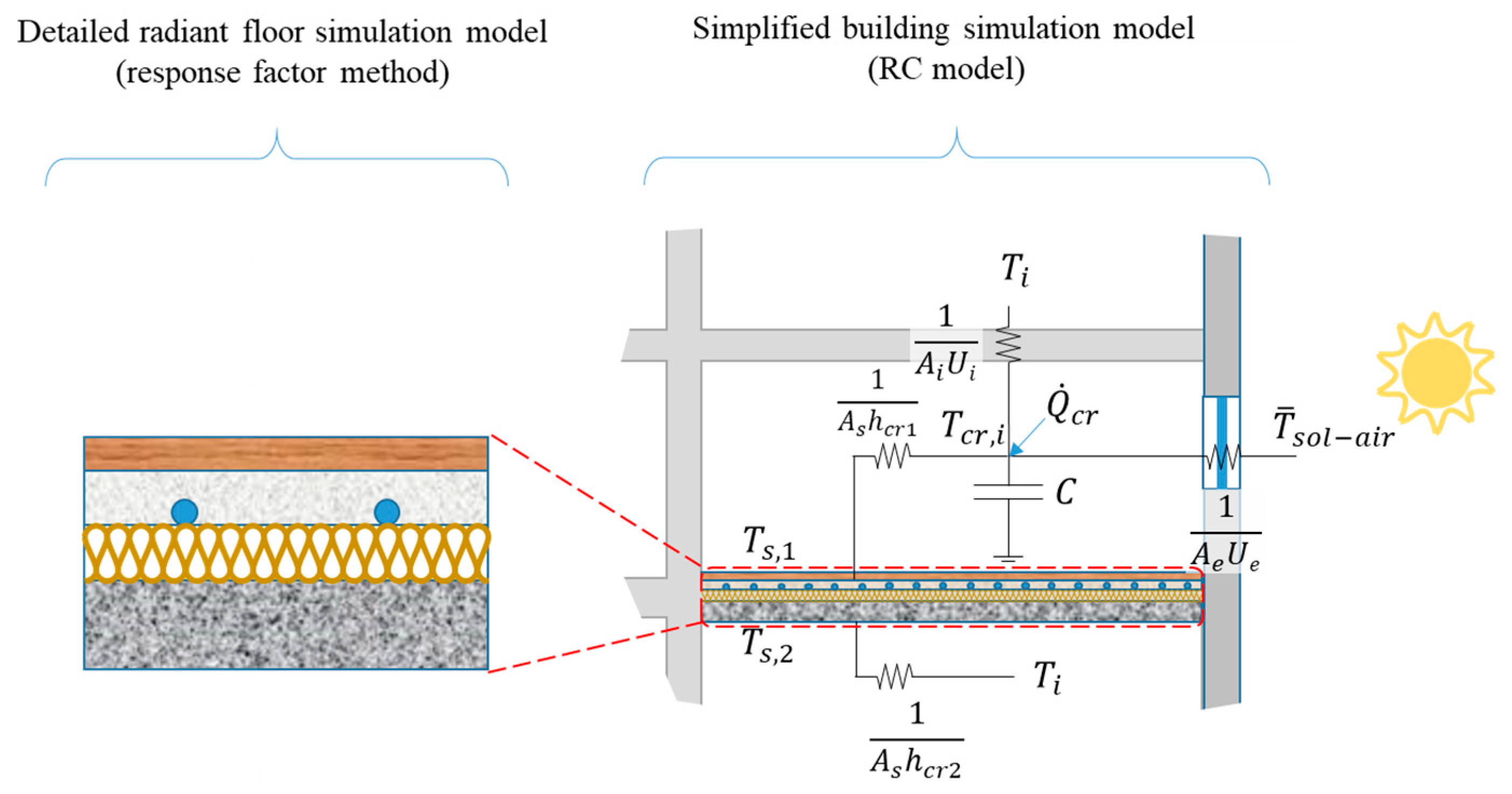
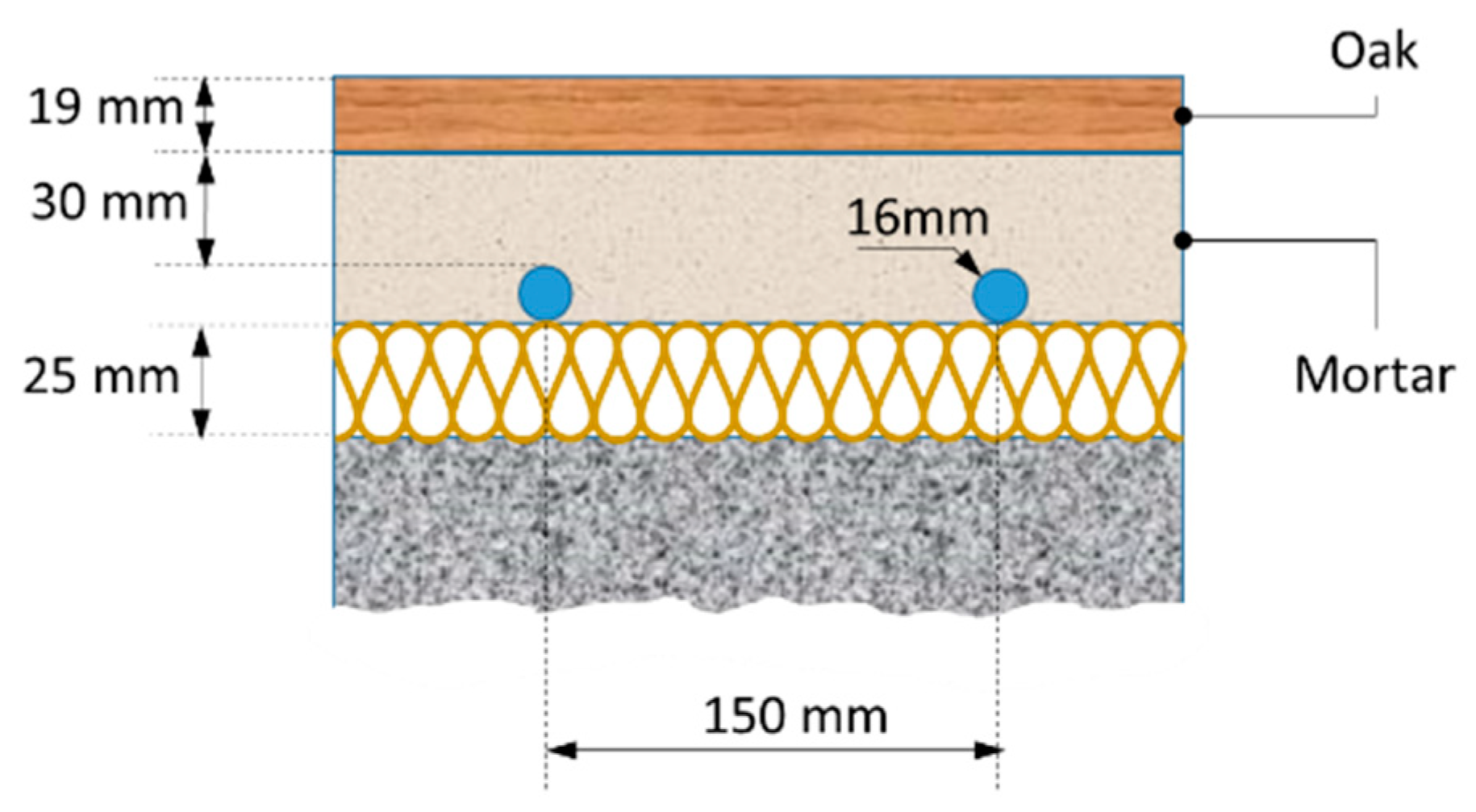

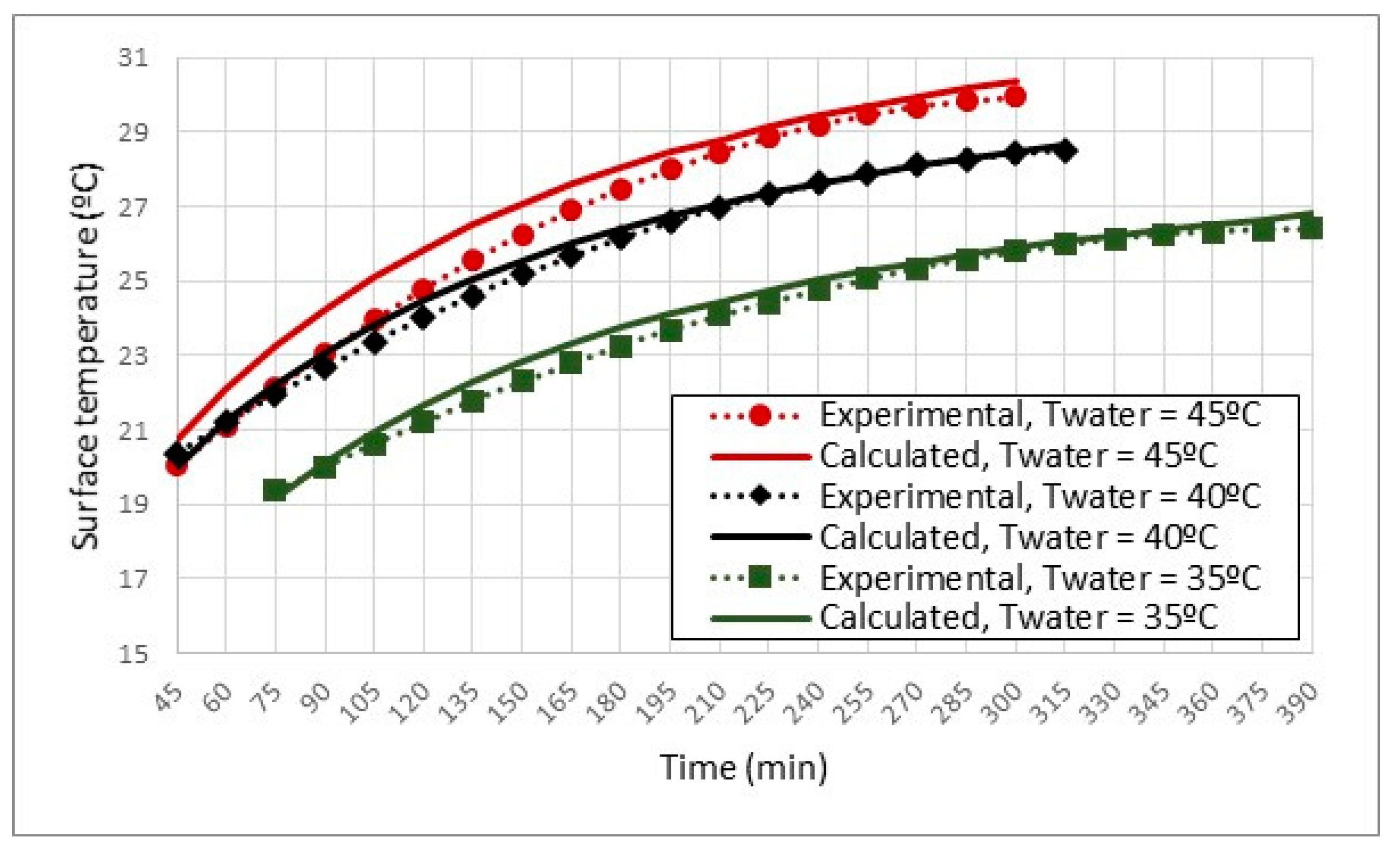







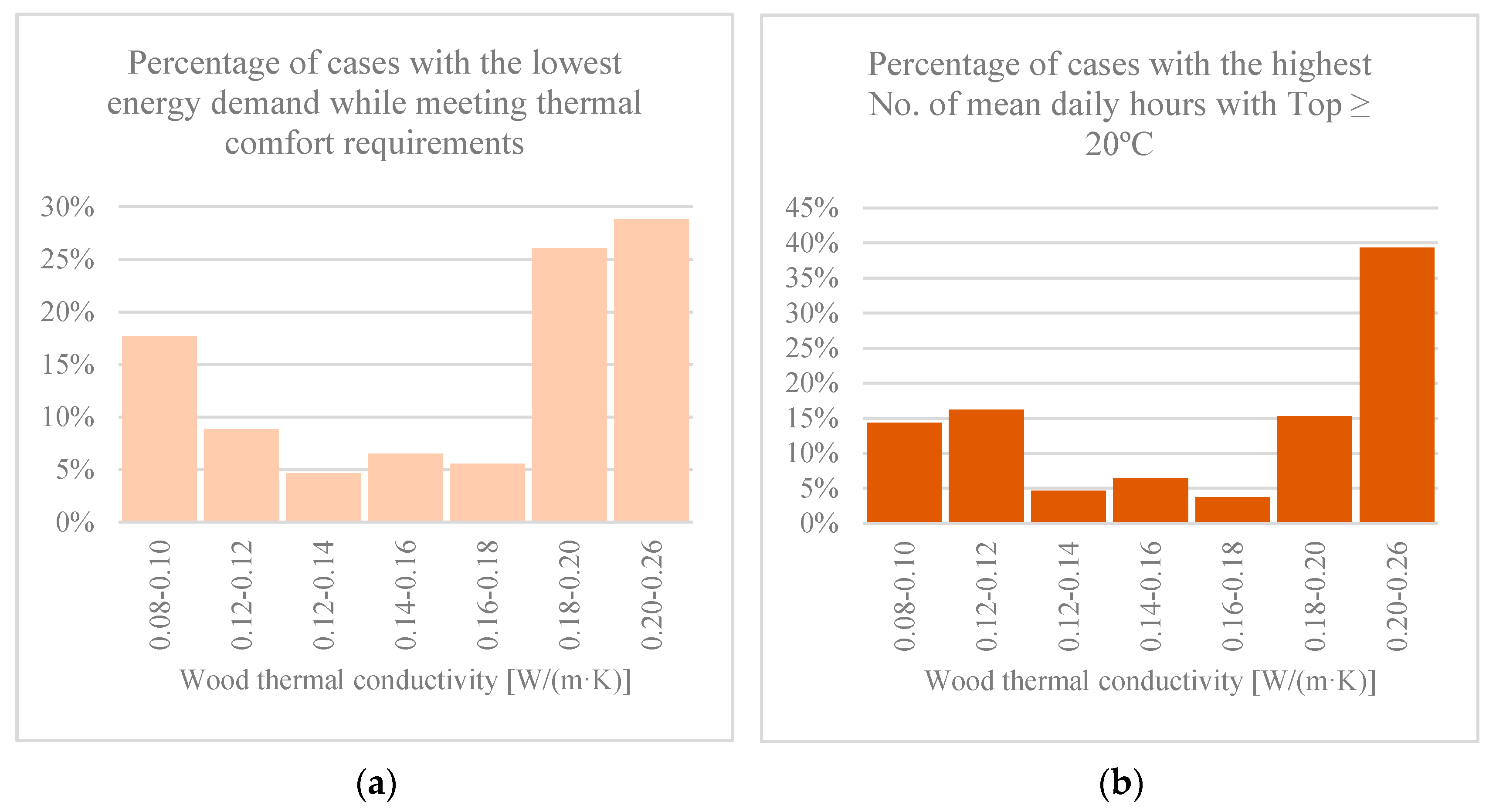
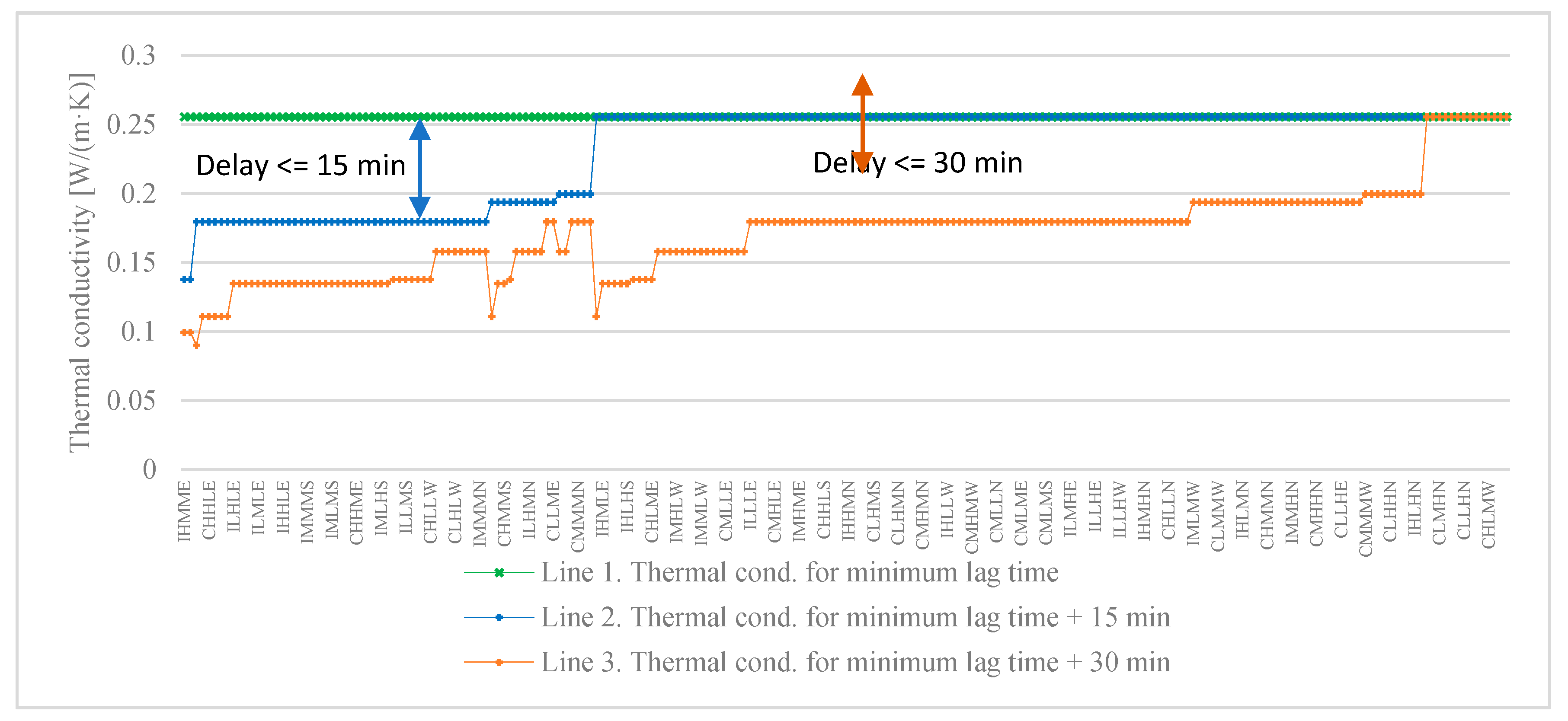
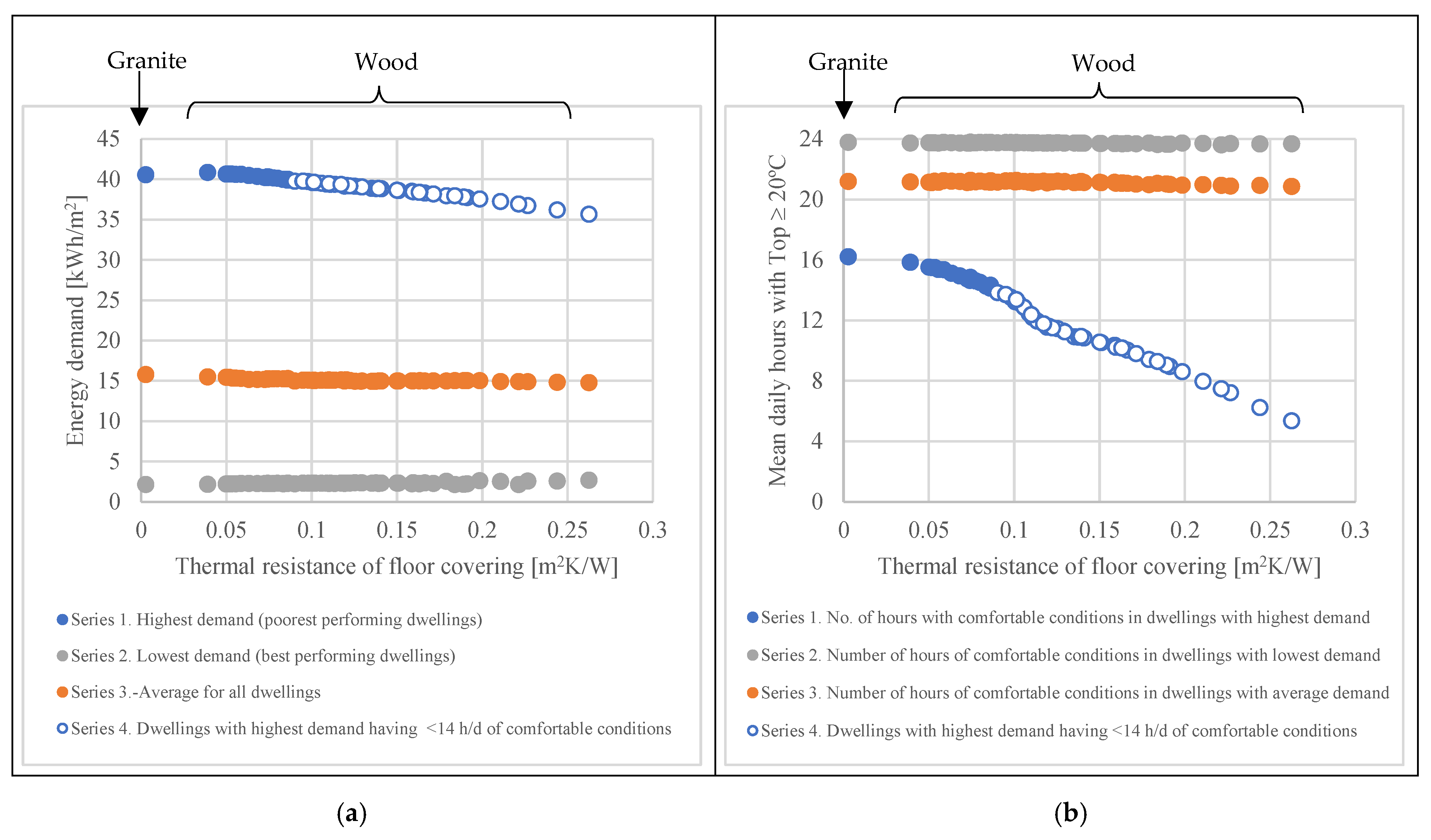

| Jan | Feb | Dec | |
|---|---|---|---|
| Chengdu (Ch) | 451 | 359 | 400 |
| Istanbul (TK) | 444 | 402 | 363 |
| London (UK) | 467 | 422 | 429 |
| Madrid (SP) | 452 | 364 | 434 |
| Tokyo (JP) | 423 | 367 | 352 |
| Thermal Conductivity W/(m·K) | Density kg/m3 | Specific Heat J/(kgK) | |
|---|---|---|---|
| Felt | 0.033 | 90 | 1000 |
| Mortar | 1.8 | 2100 | 2000 |
| Insulation | 0.033 | 30 | 1200 |
| Waffle slab | 1.22 | 1090 | 1000 |
| Trade Name | Product | Thickness (mm) | Thermal Resistance (m2K/W) |
|---|---|---|---|
| Finsa. Finfloor | Laminate floor coverings | 8–10 | 0.06–0.154 |
| Pergo Lofoten–Senja–Langeland–Svalbard | Multi-layer parquet | 14 | 0.140 |
| Pero Laminate | Laminate floor coverings | 7–9.5 | 0.051–0.07 |
| Haro. Parquet 3000/3500/4000 | Multi-layer parquet | 11–13.5 | 0.063–0.110 |
| Haro. Tritty | Laminate floor coverings | 8 | 0.065 |
| Meister | Multi-layer parquet | 11–14 | 0.084–0.143 |
| Meister | Laminate floor coverings | 9 | 0.09 |
| Junckers | Solid hardwood planks | 15–20.5 | 0.09–0.12 |
Publisher’s Note: MDPI stays neutral with regard to jurisdictional claims in published maps and institutional affiliations. |
© 2022 by the authors. Licensee MDPI, Basel, Switzerland. This article is an open access article distributed under the terms and conditions of the Creative Commons Attribution (CC BY) license (https://creativecommons.org/licenses/by/4.0/).
Share and Cite
Ruiz-Pardo, Á.; Rodríguez Jara, E.Á.; Conde García, M.; Ríos, J.A.T. Influence of Wood Properties and Building Construction on Energy Demand, Thermal Comfort and Start-Up Lag Time of Radiant Floor Heating Systems. Appl. Sci. 2022, 12, 2335. https://doi.org/10.3390/app12052335
Ruiz-Pardo Á, Rodríguez Jara EÁ, Conde García M, Ríos JAT. Influence of Wood Properties and Building Construction on Energy Demand, Thermal Comfort and Start-Up Lag Time of Radiant Floor Heating Systems. Applied Sciences. 2022; 12(5):2335. https://doi.org/10.3390/app12052335
Chicago/Turabian StyleRuiz-Pardo, Álvaro, Enrique Ángel Rodríguez Jara, Marta Conde García, and José Antonio Tenorio Ríos. 2022. "Influence of Wood Properties and Building Construction on Energy Demand, Thermal Comfort and Start-Up Lag Time of Radiant Floor Heating Systems" Applied Sciences 12, no. 5: 2335. https://doi.org/10.3390/app12052335
APA StyleRuiz-Pardo, Á., Rodríguez Jara, E. Á., Conde García, M., & Ríos, J. A. T. (2022). Influence of Wood Properties and Building Construction on Energy Demand, Thermal Comfort and Start-Up Lag Time of Radiant Floor Heating Systems. Applied Sciences, 12(5), 2335. https://doi.org/10.3390/app12052335







